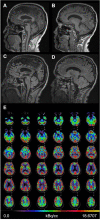Subacute cerebellar ataxia following respiratory symptoms of COVID-19: a case report
- PMID: 33761897
- PMCID: PMC7988684
- DOI: 10.1186/s12879-021-05987-y
Subacute cerebellar ataxia following respiratory symptoms of COVID-19: a case report
Abstract
Background: Severe acute respiratory syndrome virus 2 (SARS-CoV-2) is spreading globally and causes most frequently fever and respiratory symptoms, i.e. Coronavirus disease 2019 (COVID-19), however, distinct neurological syndromes associated with SARS-CoV-2 infection have been described. Among SARS-CoV-2-infections-associated neurological symptoms fatigue, headache, dizziness, impaired consciousness and anosmia/ageusia are most frequent, but less frequent neurological deficits such as seizures, Guillain-Barré syndrome or ataxia may also occur.
Case presentation: Herein we present a case of a 62-year-old man who developed a subacute cerebellar syndrome with limb-, truncal- and gait ataxia and scanning speech 1 day after clinical resolution of symptomatic SARS-CoV-2 infection of the upper airways. Apart from ataxia, there were no signs indicative of opsoclonus myoclonus ataxia syndrome or Miller Fisher syndrome. Cerebral magnetic resonance imaging showed mild cerebellar atrophy. SARS-CoV-2 infection of the cerebellum was excluded by normal cerebrospinal fluid cell counts and, most importantly, absence of SARS-CoV-2 RNA or intrathecal SARS-CoV-2-specific antibody production. Other causes of ataxia such as other viral infections, other autoimmune and/or paraneoplastic diseases or intoxication were ruled out. The neurological deficits improved rapidly after high-dose methylprednisolone therapy.
Conclusions: The laboratory and clinical findings as well as the marked improvement after high-dose methylprednisolone therapy suggest a post-infectious, immune-mediated cause of ataxia. This report should make clinicians aware to consider SARS-CoV-2 infection as a potential cause of post-infectious neurological deficits with an atypical clinical presentation and to consider high-dose corticosteroid treatment in case that a post-infectious immune-mediated mechanism is assumed.
Keywords: COVID-19; Case report; Post-infectious cerebellar ataxia; Post-infectious neurological disease; SARS-CoV-2 infection.
Conflict of interest statement
The authors have no relevant financial or non-financial competing interests to disclose.
Figures

References
-
- Frontera JA, Sabadia S, Lalchan R, Fang T, Flusty B, Millar-Vernetti P, Snyder T, Berger S, Yang D, Granger A, et al. A prospective study of neurologic disorders in hospitalized patients with COVID-19 in New York City. Neurology. 2021;96(4):e575–e586. doi: 10.1212/WNL.0000000000010979. - DOI - PMC - PubMed
Publication types
MeSH terms
Substances
Grants and funding
LinkOut - more resources
Full Text Sources
Other Literature Sources
Medical
Miscellaneous

